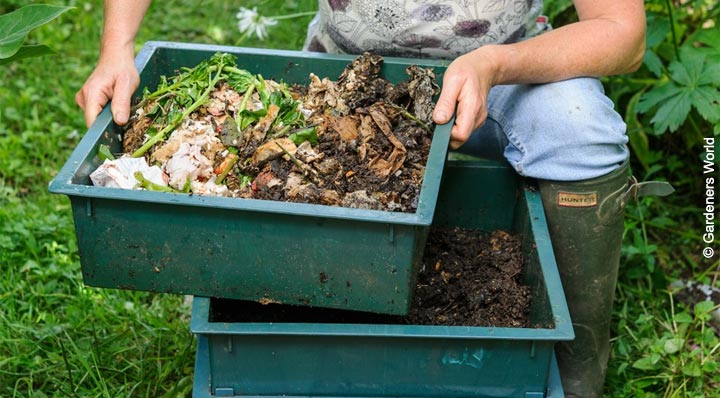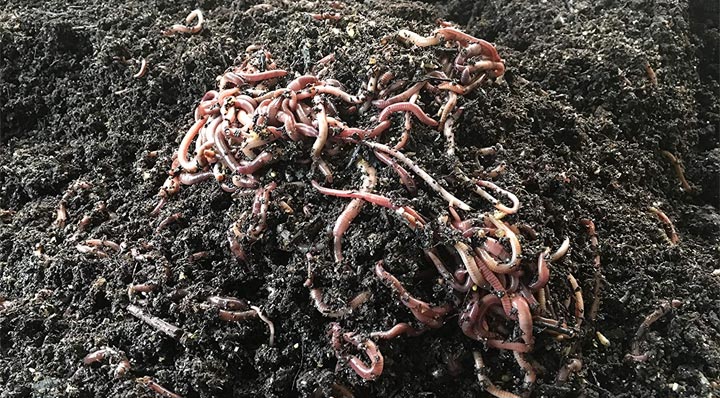A wormery is great for speedily converting your kitchen waste into super-rich organic compost and liquid plant feed.

With a multi-tray wormery you can quickly and easily recycle your kitchen scraps without even getting your hands dirty. Recycling your kitchen scraps in a wormery saves on transport costs and stops methane being produced by the food going into landfill, so it’s also an extremely satisfying and fun way to help the environment.
The wormery is one of my favourite ‘green’ products. The worms seem to devour anything we throw in: cooked food, uncooked food, bokashi waste, even shredded paper – they love it all! We add the compost to houseplants and containers, and use it when planting out new plants in the garden. Plus, the organic liquid produced gives our plants around the house and garden a real boost.
What is wormery composting?
Wormery composting uses worms in a sealed, multi-layered container to turn your kitchen scraps into super-rich compost. Add your food waste and the worms will get to work converting it into compost, and as bonus, you also get a steady supply of liquid feed to give your plants a boost.
What are the benefits of composting with worms?
Wormery compost, known to pro-gardeners as ‘black gold’, is a rich, sweet smelling compost which is full of the nutrients your plants will love – worm compost is probably the best compost there is.
Usually a wormery will produce compost at a ratio of 8:1, that is 8 buckets of food waste will produce 1 bucket of compost. Whereas conventional composting can take up to 18 months to produce good quality crumbly compost, using a wormery will speed up the process so much that you can have your first batch in as little as 3 months.
Enzymes produced in the gut of composting worms improve the nutrient content of the compost. According to wormery.co.uk, worm casts or worm worked compost is the most nutrient rich natural compost known.
How does a wormery work?
Wormeries operate in 3 layers. You add your food scraps to the top – just lift the lid and throw them in – and the worms will gather just underneath. They’ll munch their way through the fresh waste until it is well-worked. And they’ll continue to thrive just under the fresh scraps, effectively moving upwards as more and more waste is added, leaving their worm compost behind as they go.
The middle layer contains waste that has been semi-processed and some worms will continue to chomp through this material until it is fully composted. The bottom layer contains compost that has been fully worked and there is nothing left for the worms to feed on. At this stage, the worms should have separated themselves from the compost and it can be removed and used on your garden.

WORMS! Errr, Disgusting!
Typically, two types of composting worms are used, tiger worms also known as brandlings, and more acid tolerant worms called dendrobaenas or dendras. Tiger worms are reddish in colour and slightly smaller than the earthworms you are used to seeing in the garden. Dendras are bigger and can digest lots of material.
The great thing about a working wormery is that you never have to touch the worms, they just continually feed on the layer of food waste just below the surface. Typically, a wormery kit will come with 500g (approximately 1000) native composting worms, which are a mixture of tiger worms and dendras.
Impressively, worms can eat up to half their body weight everyday and one thing’s for sure, slimy as they may be, you’ll soon grow to love your worms!
Is wormery composting for me?
We think everyone should have a wormery, but if you live in a flat or only have a small outdoor space, such as a courtyard garden, without the room for a conventional compost bin, you will benefit most from owning a wormery.
The great thing about wormery composting is that you can add your waste a bit at a time; you don’t need the bulk of material associated with a compost heap. In fact, the worms prefer it if you only add a few scraps each day, rather than adding a lot in one go.
Composting worms are very self reliant and maintenance free; you can even go on holiday without worrying about asking a neighbour to ‘feed’ them, just feed the worms a good amount of food waste before you leave.
Positioning your wormery
Your wormery can be safely kept indoors and the only smell you’ll get is a nice, earthy smell. We, for example, keep our wormery in a corner in the garage. However, if you don’t want to get up close and personal with your wrigglers just yet, you can keep your wormery outside, in which case choose a sheltered spot. Just make sure you keep it somewhere handy, so you can easily add your scraps without donning hiking boots.
The most important thing to consider when thinking about positioning your wormery is the temperature – ideally neither too hot nor too cold. Wormeries work best between 10 and 25 degrees Celcius, so make sure you position your wormery in a sheltered site away from direct sunlight. If your wormery is outside, you may want to consider putting it in a shed or garage during heavy frost and insulating it in winter by wrapping it with bubble wrap or an old blanket.
Feed your worms
You can put things in your wormery that you can’t put in a compost bin, like cooked food, because it’s sealed and won’t attract vermin.
- Fruit and vegetable peelings
- Stale or moldy bread
- Crushed eggshells
- Coffee grounds and paper filters
- Tea bags
- Garden waste like grass clippings and leaves (in small amounts)
- Shredded paper waste
Don’t feed your worms
There are one or two things that you should avoid adding to your wormery. Some food scaps such as lemon peel and onion are too acidic for the worms, and some waste can attract flies.
- Meat, fish and bones
- Citrus fruit peel
- Garlic and onion
- Dairy products
- Greasy foods
You can safely compost meat, fish and dairy if you use the Bokashi Composting System. But, if in doubt, leave it out. Anything you’re not sure of can be sent to your local green waste recycling facility.
You may also like…
Composting – A Complete Guide | Bokashi Composting | Wormeries Reviewed